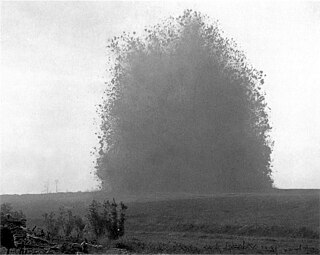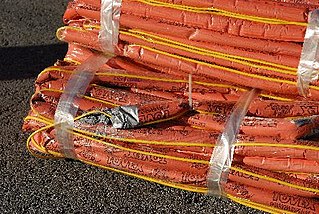Minol (explosive)
Last updatedMinol (pronounced mine-ol) is a military explosive developed by the Admiralty early in the Second World War to augment supplies of trinitrotoluene (TNT) and RDX, which were in short supply. The aluminium component in Minol significantly prolongs the explosive pulse, making it ideal for use in underwater naval weapons (e.g. naval mines, for which it was developed, depth charges and torpedoes) where munitions with a longer explosive pulse are more destructive than those with high brisance. [1] : M139 Minol cannot be used in weapons fired from gun barrels (e.g. artillery shells) because there is a risk of detonation when subjected to over 250 gs of acceleration.[ citation needed ] Initially, three Minol formulas were used. All percentages shown are by weight:
- Minol-1: 48% TNT, 42% ammonium nitrate (AN) and 10% powdered aluminium
- Minol-2: 40% TNT, 40% ammonium nitrate and 20% powdered aluminium
- Minol-3: 42% TNT, 38% ammonium nitrate and 20% powdered aluminium [1] : M136
These three Minols suffered from expansion, spewing and gassing due to the reaction of fine aluminium powder with moisture and structural phase transitions in ammonium nitrate. To improve stability of Minol and increase production, more coarse aluminium powder was introduced. Later it was found that aluminium chips, such as filings, flakes and shavings, also gave good performance and improved stability. [1] : M136–M137
To solve the problem with dimensional instability, pure ammonium nitrate was replaced by a solid solution of 10% of potassium nitrate in ammonium nitrate. Thus, a new formula was adopted:
- Minol-4: 40% TNT, 36% ammonium nitrate, 4% potassium nitrate and 20% powdered aluminium [2] [1] : M137
The addition of potassium nitrate minimized expansion of Minol, making it more stable to temperature changes than TNT, but didn't solve the expansion problem. Minol IV could still expand and develop cracks after prolonged thermal cycling. A new composition, with 20% of potassium nitrate in solid solution, was developed. It didn't expand or crack even when cycled for months, but wasn't adopted for production and service. [1] : M137
Since the 1950s, Minol has been superseded by more modern PBX compositions, due to their superior explosive yield and stability when being stored; Minol is regarded as obsolete. Generally, any Minol-filled munitions encountered will be in the form of legacy munitions or unexploded ordnance dating from before the 1960s.
See also
Related Research Articles

RDX (abbreviation of "Research Department eXplosive") or hexogen, among other names, is an organic compound with the formula (CH2N2O2)3. It is white, odorless and tasteless, widely used as an explosive. Chemically, it is classified as a nitroamine alongside HMX, which is a more energetic explosive than TNT. It was used widely in World War II and remains common in military applications.

Dynamite is an explosive made of nitroglycerin, sorbents, and stabilizers. It was invented by the Swedish chemist and engineer Alfred Nobel in Geesthacht, Northern Germany, and was patented in 1867. It rapidly gained wide-scale use as a more robust alternative to the traditional black powder explosives. It allows the use of nitroglycerine's favorable explosive properties while greatly reducing its risk of accidental detonation.

An explosive is a reactive substance that contains a great amount of potential energy that can produce an explosion if released suddenly, usually accompanied by the production of light, heat, sound, and pressure. An explosive charge is a measured quantity of explosive material, which may either be composed solely of one ingredient or be a mixture containing at least two substances.

Trinitrotoluene, more commonly known as TNT, more specifically 2,4,6-trinitrotoluene, and by its preferred IUPAC name 2-methyl-1,3,5-trinitrobenzene, is a chemical compound with the formula C6H2(NO2)3CH3. TNT is occasionally used as a reagent in chemical synthesis, but it is best known as an explosive material with convenient handling properties. The explosive yield of TNT is considered to be the standard comparative convention of bombs and asteroid impacts. In chemistry, TNT is used to generate charge transfer salts.

A solid-propellant rocket or solid rocket is a rocket with a rocket engine that uses solid propellants (fuel/oxidizer). The earliest rockets were solid-fuel rockets powered by gunpowder; The inception of gunpowder rockets in warfare can be credited to ancient Chinese ingenuity, and in the 13th century, the Mongols played a pivotal role in facilitating their westward adoption.

Ammonium nitrate is a chemical compound with the formula NH4NO3. It is a white crystalline salt consisting of ions of ammonium and nitrate. It is highly soluble in water and hygroscopic as a solid, although it does not form hydrates. It is predominantly used in agriculture as a high-nitrogen fertilizer.

Amatol is a highly explosive material made from a mixture of TNT and ammonium nitrate. The British name originates from the words ammonium and toluene. Similar mixtures were known as Schneiderite in France. Amatol was used extensively during World War I and World War II, typically as an explosive in military weapons such as aircraft bombs, shells, depth charges, and naval mines. It was eventually replaced with alternative explosives such as Composition B, Torpex, and Tritonal.

A shell, in a military context, is a projectile whose payload contains an explosive, incendiary, or other chemical filling. Originally it was called a bombshell, but "shell" has come to be unambiguous in a military context. A shell can hold a tracer.

Tritonal is a mixture of 80% TNT and 20% aluminium powder, used in several types of ordnance such as air-dropped bombs. The aluminium increases the total heat output and hence impulse of the TNT — the length of time during which the blast wave is positive. Tritonal is approximately 18% more powerful than TNT alone.

Ammonal is an explosive made up of ammonium nitrate and aluminium powder, not to be confused with T-ammonal which contains trinitrotoluene as well to increase properties such as brisance. The mixture is often referred to as Tannerite, which is a brand of ammonal.

Flash powder is a pyrotechnic composition, a mixture of oxidizer and metallic fuel, which burns quickly (deflagrates) and produces a loud noise regardless of confinement. It is widely used in theatrical pyrotechnics and fireworks and was once used for flashes in photography.

Torpex is a secondary explosive, 50% more powerful than TNT by mass. Torpex comprises 42% RDX, 40% TNT and 18% powdered aluminium. It was used in the Second World War from late 1942, at which time some used the names Torpex and RDX interchangeably, much to the confusion of today's historical researchers. Torpex proved to be particularly useful in underwater munitions because the aluminium component had the effect of making the explosive pulse last longer, which increased the destructive power. Besides torpedoes, naval mines, and depth charges, Torpex was only used in the Upkeep, Tallboy and Grand Slam bombs as well as the drones employed in Operation Aphrodite. Torpex has long been superseded by H6 and Polymer-bonded explosive (PBX) compositions. It is therefore regarded as obsolete and Torpex is unlikely to be encountered except in old munitions or unexploded ordnance, although a notable exception to this is the Sting Ray lightweight torpedo, which as of October 2020 remains in service with the Royal Navy and several foreign militaries. The German equivalent of Torpex was Trialen.
A pyrotechnic composition is a substance or mixture of substances designed to produce an effect by heat, light, sound, gas/smoke or a combination of these, as a result of non-detonative self-sustaining exothermic chemical reactions. Pyrotechnic substances do not rely on oxygen from external sources to sustain the reaction.
Composition H-6 is a melt-cast military aluminized high explosive. H-6 was developed in the US
Oxygen balance is an expression that is used to indicate the degree to which an explosive can be oxidized, to determine if an explosive molecule contains enough oxygen to fully oxidize the other atoms in the explosive. For example, fully oxidized carbon forms carbon dioxide, hydrogen forms water, sulfur forms sulfur dioxide, and metals form metal oxides. A molecule is said to have a positive oxygen balance if it contains more oxygen than is needed and a negative oxygen balance if it contains less oxygen than is needed.
In pyrotechnics, a pyrotechnic initiator is a device containing a pyrotechnic composition used primarily to ignite other, more difficult-to-ignite materials, such as thermites, gas generators, and solid-fuel rockets. The name is often used also for the compositions themselves.
Hexanite was a castable German military explosive developed early in the 20th century before the First World War for the Kaiserliche Marine, intended to augment supplies of trinitrotoluene (TNT), which were then in short supply. Hexanite is slightly less powerful than TNT on its own. The most common hexanite formula was 60% TNT and 40% hexanitrodiphenylamine.
Explosive materials are produced in numerous physical forms for their use in mining, engineering, or military applications. The different physical forms and fabrication methods are grouped together in several use forms of explosives.

A water-gel explosive is a fuel sensitized explosive mixture consisting of an aqueous ammonium nitrate solution that acts as the oxidizer. Water gels that are cap-insensitive are referred to under United States safety regulations as blasting agents. Water gel explosives have a jelly-like consistency and come in sausage-like packing stapled shut on both sides.
References
- 1 2 3 4 5 J. Hendrikson (January 1, 1978). "Minol". Encyclopedia of explosives and related items. By Seymour M. Kaye. Vol. 8. Picatinny Arsenal. pp. M135–M143. LCCN 61-61759.
- ↑ Boyars, Carl; Holden, James R.; Bertram, Albert L. (March 29, 1973). Minol IV, A New Explosive Composition Containing Ammonium Nitrate-Potassium Nitrate Solid Solution. Maryland: Naval Ordnance Laboratory.
Text is available under the CC BY-SA 4.0 license; additional terms may apply.
Images, videos and audio are available under their respective licenses.